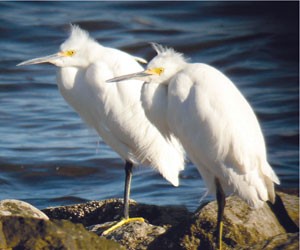One of Northwest Florida’s best meeting resources has nothing to do with technology or square footage. Open a window and you’ll see it—a glorious natural landscape that sweeps from sand dunes to oak trees, from rushing rivers and deep springs to the ocean floor. It’s yours for the taking when you want to take a meeting from routine to inspirational.
The great outdoors can have that effect on attendees.
"I’ve been to so many meetings when you get on an airplane, get to the hotel and you’re just in a conference room the whole time," says Laura Lee, communications manager for the Pensacola Bay Area CVB. "If you can get outside and enjoy the natural beauty of the area, it does make a big difference. I think it makes you more motivated in your meeting."
So get the group going, literally. With nature right outside the door in Northwest Florida, you’re stepping into a world of possibilities.
Pensacola
The westernmost city in Northwest Florida, Pensacola is also the gateway to Gulf Islands National Seashore, the largest tract of unprotected seashore in the country, showcasing 52 miles of undeveloped coastline populated mostly by shorebirds and, during spring and fall, flocks of migrating flycatchers, warblers, tanagers and other species.
"Our meeting attendees love to go out there," Lee says. "Park rangers are available to give tours. They do barrier island walks, star-gazing trips and snorkeling adventures, and they look for sea turtles. It’s wonderful because it’s free."
At nearby Big Lagoon State Park, your group might join an interpretive program to learn all about dragonflies and damselflies before gathering in the park’s 500-seat amphitheater, equipped with a meeting room and kitchen. Then again, they might get a kick out of planting seagrass out at Project Greenshores, a 30-acre salt marsh created by the Florida Department of Environmental Protection to boost local estuarine habitats.
"Groups can plant seagrass in the lab, then go out and put it in the water and basically learn about the whole cycle of life in this estuary," Lee says.
Emerald Coast
In neighboring Destin/Fort Walton Beach, the lovely Emerald Coast Conference Center on Okaloosa Island is the starting point for a host of outdoor adventures. For one thing, a green oasis called Marler Park is set directly behind the center on Choctawhatchee Bay, and "groups will take boxed lunches out there and get some fresh air," reports Sarah Leahy, travel industry sales manager for the Emerald Coast CVB. "There are benches and a small interpretive trail for strolling."
Close by is Henderson Beach State Park—featuring a nature trail through a coastal forest of sand pines and scrub oak—with two new pavilions to accommodate SMERF or corporate groups. "We hosted a military director’s fam back in October and took our group to Henderson," notes Sherry Rushing, CTIS, travel industry sales director for the CVB. "We had a picnic out there, then took the boardwalk down to the beach. Everyone took their shoes off for a group photo on the beach."
Of course, beyond the beach is the beautiful emerald-blue Gulf of Mexico, where dolphins frolic for appreciative audiences aboard cruise boats like the Hannah Marie and Miss Florida, operated by Olin Marler’s Charter Fishing, and the Southern Star, which has catering and bar service for private parties and other group events. Both fleets feature glass-bottom viewing areas for prime dolphin-watching and other wonders waiting below the waves, including colorful sponges, aqua and purple sea whips and reef clusters of white star and ivory tree coral.
"Both the Southern Star and Olin Marler boats can handle up to 149 people," Rushing notes. "They can be seated theater style and there are monitors on board if you wanted to show a DVD or something like that."
Beaches of South Walton
Nature’s ability to de-stress becomes ever more apparent in Destin’s neighbor to the east—the Beaches of South Walton—an enclave of 15 Old Florida-style coastal communities fronted by pristine white-sand beaches.
How important is the environment here? Forty percent of the land is protected as state park lands. Among them are the 15,000-acre Point Washington State Forest, with more than 10 miles of trails, and Topsail Hill State Preserve, named for a 25-foot-high sand dune and encompassing acres of Gulf-front pine forests and wetlands, as well as three rare coastal dune lakes. Found only in Australia, New Zealand, Madagascar and Northwest Florida, these lakes at first glance appear to be a part of the Gulf simply cut off by sandbars or dunes. But in reality, they are freshwater pools set within feet of the salty ocean. One of the region’s most beautiful parks is Eden State Gardens, whose moss-draped live oaks, ornamental gardens (including a secret rose garden), walking trails and panoramic views of Tucker Bayou also make it one of most peaceful spots in the state. A pavilion and designated areas of the grounds and lawns are available for group events. One of the area’s oldest communities, Grayton Beach, also boasts one of its most pristine preserves, Grayton Beach State Recreation Area, where visitors may catch a glimpse of loggerhead and green sea turtles nesting on the beaches from May to September.
"We are the home of the endangered loggerhead turtle," notes Pamela Watkins, CTIS, director of sales and special events for the Beaches of South Walton. "Only one out of 10,000 hatchlings makes it to maturity," she explains, "so we have a volunteer program of people who make sure the nests are protected."
If your group visits during nesting season or hatching season (July-October), they can help mark and monitor nests through South Walton Turtle Watch, one of several corporate social responsibility programs that allow visitors to "give back" to the community during their stay.
"People want to do something as a group while they’re here," Watkins says. "And they want to learn something."
Panama City Beach
This beach community rarely stands still, as volleyball players, shell collectors and beach club-goers keep the gleaming white sands lively. But Panama City Beach has its quieter, natural side as well, as visitors discover in places like St. Andrews State Park, a former military reservation now offering over a mile of beaches on the Gulf of Mexico and Grand Lagoon.
Two nature trails wind through coastal plant communities in St. Andrews, and delegates also may enjoy swimming, snorkeling, scuba diving, kayaking, canoeing and fishing. From St. Andrews, "one of the cool things that groups can do is rent a pontoon boat and go over to Shell Island," says Dan Rowe, CEO of the Panama City Beach CVB. "People who have no boating experience can captain a pontoon. It’s a wonderful group experience."
On the way to the island, attendees are likely to glimpse bottlenose dolphins and be greeted on shore by pelicans, sandpipers and gulls. In addition, the waters around Shell Island are dense with fish, sea turtles and artificial reefs, making it a diver’s dream—not unlike the entire Panama City Beach area.
"We have 25 artificial reefs for diving and snorkeling, including a tugboat we sank last summer as well as part of a bridge that we sank," Rowe says.
Farther inland, Panama City Beach expands into an ecotourist’s nirvana of parks and canoe trails, including one at Econfina Creek, which winds for 22 miles through limestone walls, lush vegetation and sand bluffs.
Tallahassee
Heading away from the coast, you might think things would start to dry out; that is, until you caught sight of the lakes, rivers and springs surrounding Florida’s capital city of Tallahassee. Moreover, the landscape changes—almost drastically—from sand dunes and coastal marshes to rolling hills and the old-growth oak trees and magnolias that form Tallahassee’s famed canopy roads.
"You get a different perspective of Florida here. We’ve got more oak trees than stop lights," says Kerri Post, senior marketing manager of Visit Tallahassee, the city’s tourism marketing group. "We also have some really unique venues that can absolutely immerse you in a nature-based experience."
Chief among these, Post says, is Wakulla Springs, home to one of the world’s largest and deepest freshwater springs, where a historic lodge can accommodate groups in classroom, theater or banquet settings before they embark on their adventure in the spring or the spring-fed Wakulla River, which flows nine miles before it merges with the St. Marks River at San Marcos de Apalache Historic State Park
"There’s a boat ride to take you out on the river, where you will see manatees year round," Post says. "Literally, you walk from your meeting space out to the dock. It’s a wonderful, wild, natural area that’s a stone’s throw from the capital city."
In fact, springs like Wakulla were one of the state’s original attractions, as spring-side health resorts once touted their supposed healing qualities. Today, though some experienced divers explore the cave systems beneath the surface, most visitors enjoy swimming, tubing or paddling across pristine spring waters.
"It’s wonderfully refreshing. They stay at about 72 degrees all year," Post says. "Some springs are just this magical blue, and you can look straight down 60 feet and see fish as if they were suspended in air."
Back on dry land, Maclay Gardens State Park will surround delegates in colorful—not to mention fragrant—splendor, as they stroll a picturesque brick walkway, explore a secret garden or ponder a reflection pool amid hundreds of azaleas and camellias. A small cottage is available for group use.
"In the spring, it’s breathtaking," Post notes. "It’s truly a symphony of color, everywhere you look."






